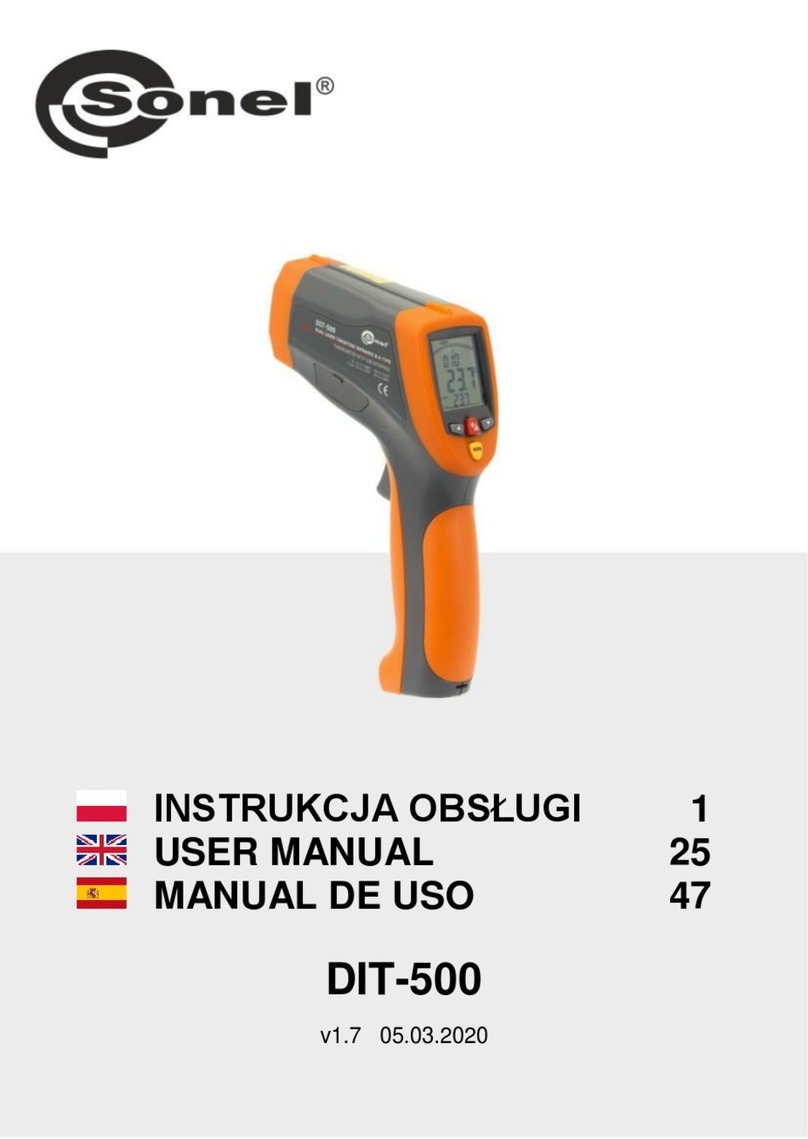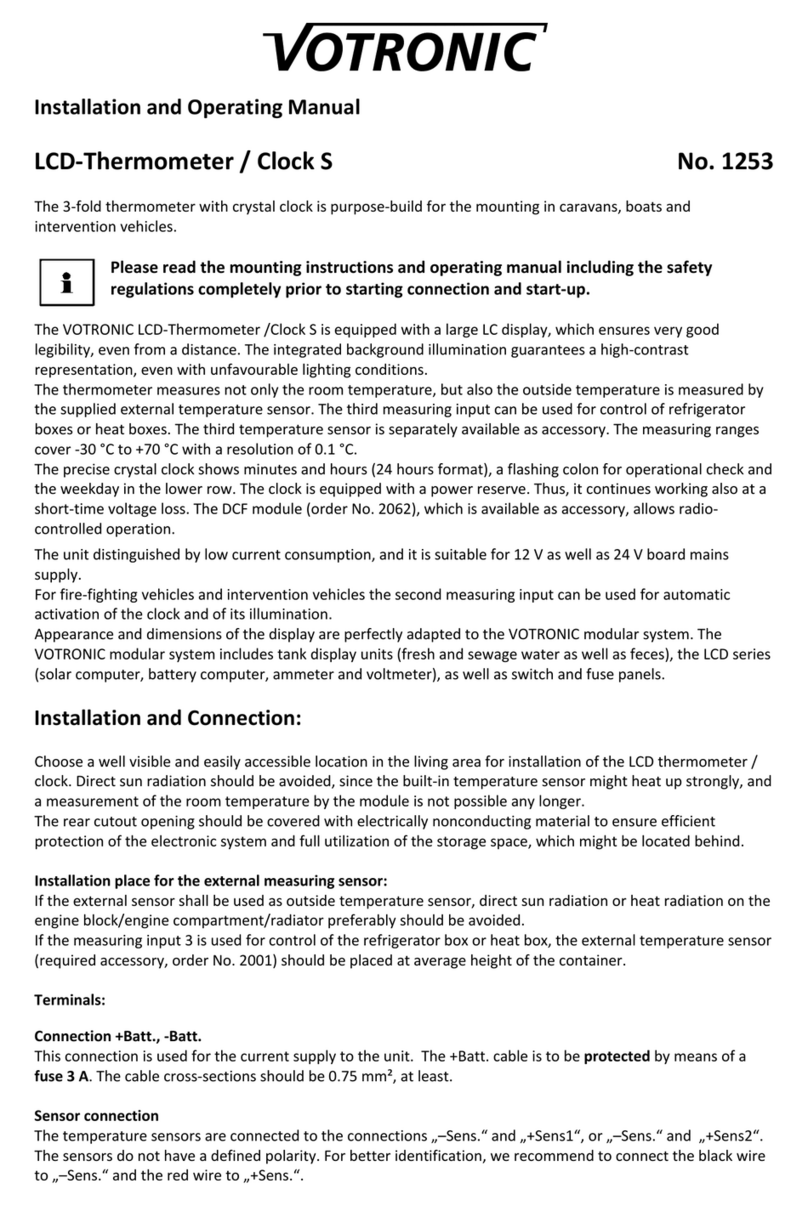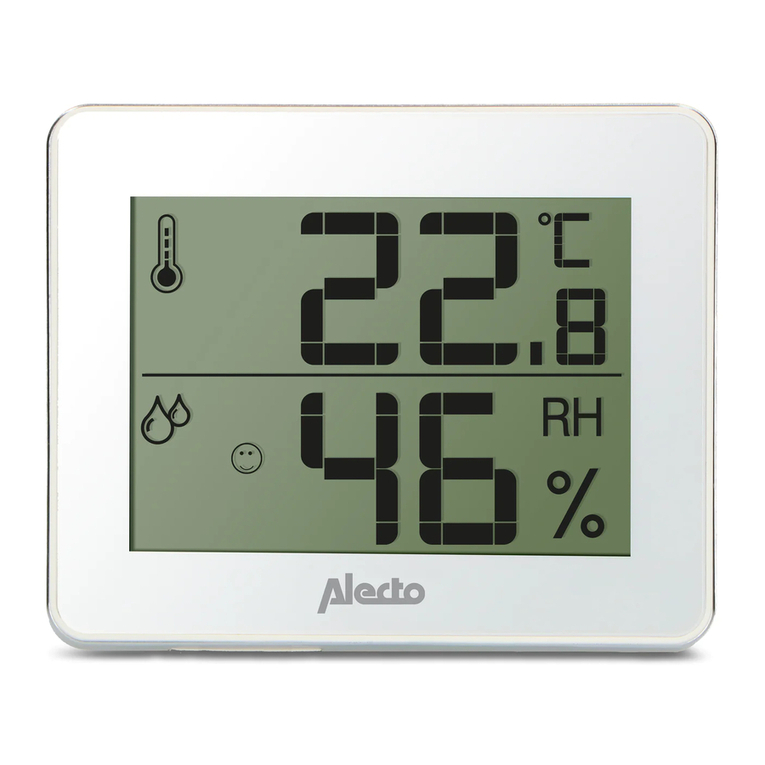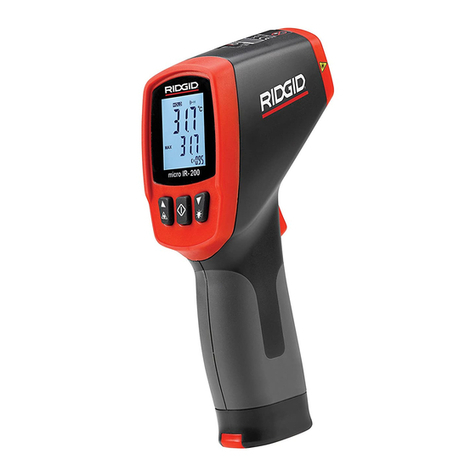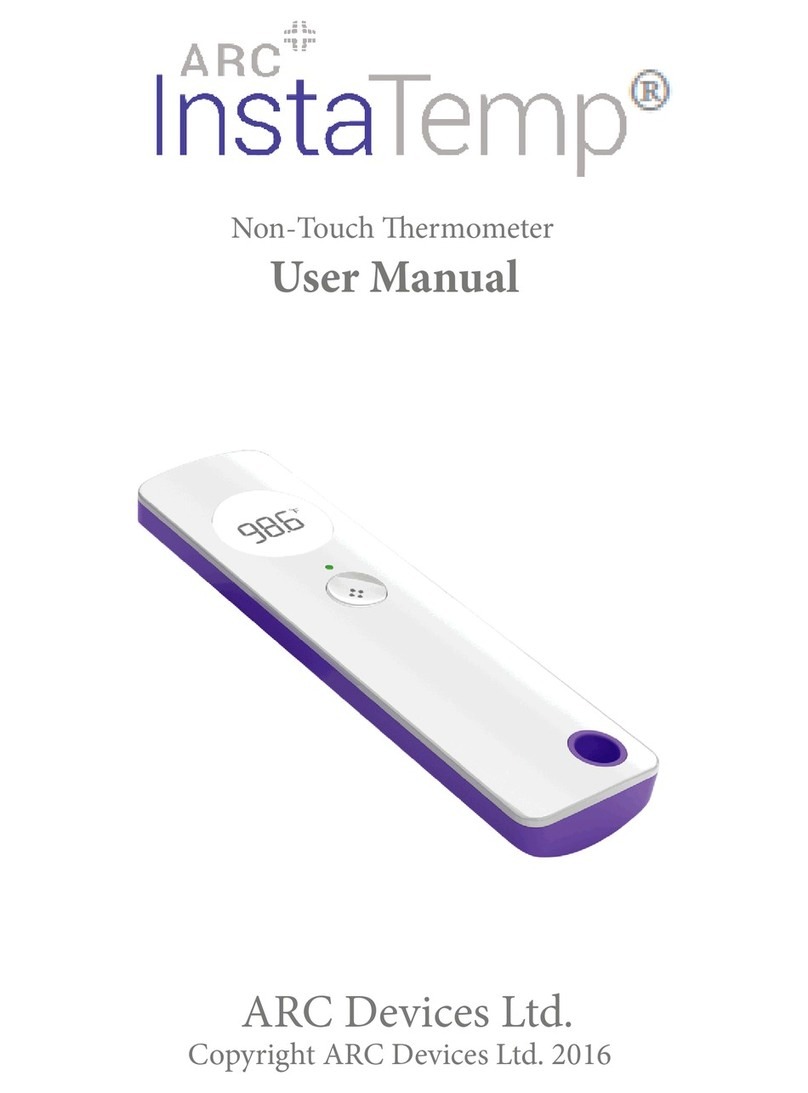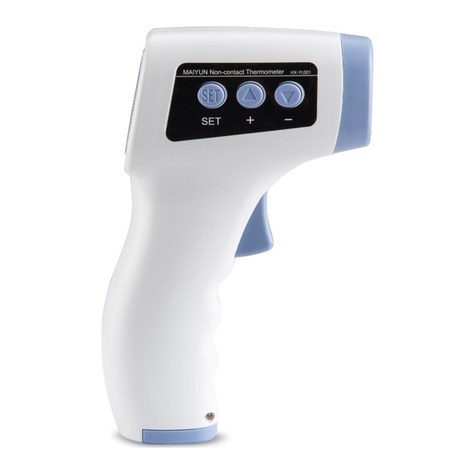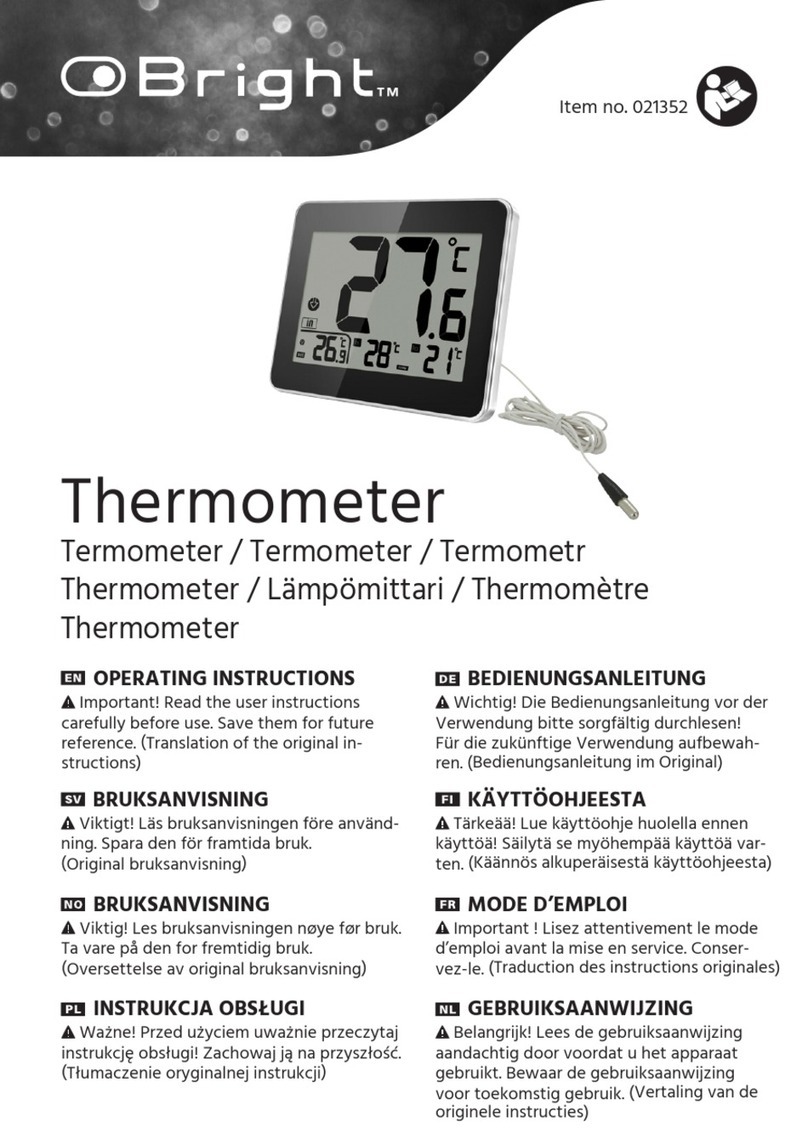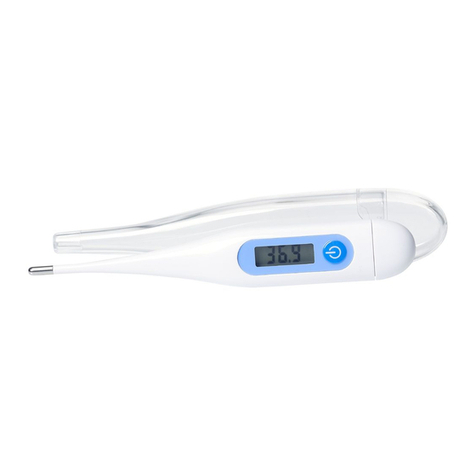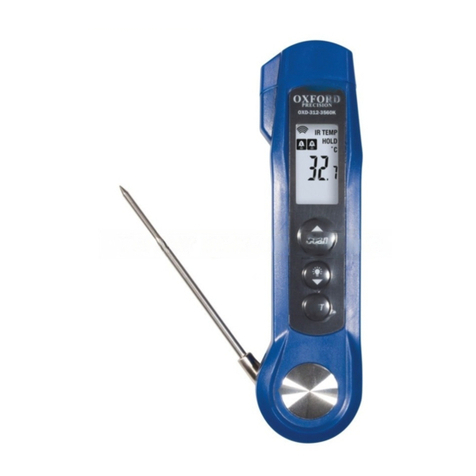Sonel DIT-130 User manual

1
OPERATING MANUAL
NON-CONTACT INFRARED
THERMOMETER
DIT-130
Version 1.5

2
Main features of the DIT-130 device are the following:
•Precise non-contact temperature measurement.
•Type K temperature Measurement.
•Modern housing design.
•Built-in laser pointer.
•Automatic Data Hold.
•Automatic Power Off.
•°C/°F switch.
•Emissivity Digitally adjustable from 0,10 to 1,00.
•MAX,MIN,DIF, AVG rekord.
•LCD with Backlight.
•Automatic range selection.
•Resolution 0,1ºC (0,1ºF).
•Trigger lock.
•High and Low alarm.
•Obtain Emissivity.
WIDE RANGE APPLICATION:
Temperature measurements of electric devices, food
preparation, safety and fire inspectors, plastic molding, asphalt,
marine and screen printing, measure ink and dryer temperature,
Diesel and fleet maintenance.

3
TABLE OF CONTENTS
1
INTRODUCTION...................................................4
2
SAFETY...................................................................5
3
FUNCTIONAL DESCRIPTION............................6
3.1
DEVICES DESCRIPTION ...............................................................6
3.2
INDICATOR.................................................................................7
3.3
BUTTONS....................................................................................7
3.4
MODE BUTTON FUNCTION........................................................8
4
DISTANCE & SPOT SIZE...................................10
5
SWITCHING C/F , LOCK ON/OFF AND SET
ALARM ..................................................................10
6
HOW IT WORKS.................................................11
7
MEASUREMENT OPERATION........................ 14
8
DATA LOGGER...................................................15
8.1
STORING DATA ........................................................................15
8.2
RECALLING DATA....................................................................16
8.3
LOG CLEAR FUNCTION.............................................................16
9
BATTERY REPLACEMENT.............................. 16
10
CLEANING AND MAINTENANCE .................. 17
11
STORAGE .............................................................17
12
DISMANTLING AND UTILIZATION ..............17
13
TECHNICAL DATA ............................................18
14
STANDARD EQUIPMENT ................................. 19
15
MANUFACTURER ..............................................20

4
1 Introduction
Thank you for purchase of the IR Thermometer. This is capable
of non-contact (infrared) temperature measurements at the touch of
a button. The built-in laser pointer increases target accuracy while
the backlight LCD and handy push-buttons combine for convenient,
ergonomic operation.
The Non-contact Infrared Thermometers can be used to
measure the temperature of objects’ surface that is improper to be
measured by traditional (contact) thermometer (such as moving
object, the surface with electricity current or the objects which are
uneasy to be touched.)
Proper use and care of this meter will provide years of reliable
service.
In the present manual we apply three kinds of warnings. These
are texts in frames, which describe possible dangers both for the
user and the meter itself. The messages starting from the word
‘WARNING:’ describe situations which imply a risk for life or health
should the recommendations presented in the present manual not
be observed. The word ‘ATTENTION!’ introduces a description of a
situation where non-observance of the recommendations presented
in the present manual may imply damage for the meter. Indications
of possible problems are preceded by the word ‘Attention:’.
WARNING:
Before using the instrument acquaint yourself with the
present manual and observe the safety regulations and
recommendations specified by the manufacturer.

5
2 Safety
In order to guarantee proper operation and correctness of the
obtained results it is necessary to observe the following recom-
mendations:
•Use extreme caution when the laser beam is turned on.
•Do not let the beam enter your eye, another person’s eye or the
eye of an animal.
•Be careful no to let the beam on a reflective surface strike your
eye.
•Do not allow the laser light beam impinge on any gas which can
explode
•It is prohibited to operated the meter:
⇒If it is damaged and completely or partially out of order
⇒If it has been stored for an excessive period of time in
inadequate conditions (e.g. if it is humid)
•Before commencing a measurement make sure the correct
measurement function has been selected,
•Repairs must be realised solely by an authorised service
workshop

6
3 Functional description
3.1
Devices description
①IR sensor
②Laser pointer beam
③LCD Display
④DOWN BUTTON
⑤UP BUTTON
⑥MODE BUTTON
⑦laser/backlight button
⑧Measurement Trigger
⑨Handle Grip
⑩Battery Cover

7
3.2
Indicator
① Data hold
② Measuring indication
③ Emissivity symbol and value
④ °C/°F symbol
⑤ Auto obtain Emissivity
⑥ lock and laser” on” symbols
⑦ High alarm and low alarm symbol
⑧ Temperature values for the MAX, MIN, DIF, AVG HAL, LAL.
And TK
⑨ Symbols for EMS MAX, MIN, DIF, AVG, HAL, LAL and TK
⑩ Current temperature value
⑪ Low battery
3.3
Buttons

8
① Up button (for EMS,HAL,LAL)
② MODE button (for cycling through the mode loop)
③ Down button (for EMS,HAL,LAL)
④ Laser/Backlight on/off button
3.4
MODE Button Function
MODE

9
The infrared thermometer
measures Maximum (MAX),
Minimum (MIN), Differential (DIF),
and Average (AVG) Temp. Each
time you take a reading. This data is
stored and can be recalled with the
MODE button until a new
measurement is taken. When the
trigger is pulled again, the unit will
begin measuring in the last mode
selected.
Pressing the MODE button also
allows you to access the High Alarm
(HAL), Low Alarm (LAL), Emissivity
(EMS). Each time you Press MODE,
you advance through the mode
cycle.
Pressing the MODE button also
allows you to access the Type K
Temp. measurement and memory
mode (LOG).
The diagram shows the
sequence of functions in the MODE
cycle.
HAL
LAL
TK
LOG
MAX
MIN
DIF
AVG
EMS
MODE
E

10
4 Distance & Spot Size
As the distance (D) from the object increases, the spot size (S)
of the area measured by the unit becomes larger. The relationship
between distance and spot size for each unit is listed below. The
focal point for each unit is 914mm (36”). The spot sizes indicate
90% encircled energy.
D:S=13:1
Sensor Beam
D
30@390
10@130 50@650
mm
Distance(D) to Spot Size(S) inch
16mm
1.2@15.6
0.4@5.2 2.0@26
Laser Beam
S
Fig: 1
5 Switching C/F , LOCK ON/OFF and SET
ALARM
① °C/°F
② LOCK ON/OFF
③ SET ALARM
Select the temperature units (
o
C or
o
F) by using the
o
C/
o
F
switch.

11
To lock the unit on for continuous measurement, slide the
middle switch LOCK ON/OFF right. If the trigger is pulled while the
unit is locked on, the laser and backlight will be turned on if they
have been activated. When the unit is locked on, the backlight and
laser will remain on unless it is turned off using the Laser/Backlight
button on the keypad.
To activate the alarms, please slide the bottom switch SET
ALARM right.
To set values for the High Alarm (HAL), Low Alarm (LAL) and
Emissivity (EMS), firstly active the display by pulling the trigger or
pressing the MODE button, then press the MODE button until the
appropriate code appears in the lower left corner of the display,
press the UP and DOWN buttons to adjust the desired values.
6 How it Works
How it Works
Infrared thermometers measure the surface temperature of an
object. The unit’s optics sense emitted, reflected, and transmitted
energy, which is collected and focused onto a detector. The unit’s
electronics translate the information into a temperature reading,
which is display on the unit. In units with a laser, the laser is used
for aiming purposes only.
Field of View
Make sure that the target is larger than the unit’s spot size. The
smaller the target, the closer you should be to it. When accuracy is
critical, make sure the target is at least twice as large as the spot
size.

12
Distance & Spot Size
As the distance (D) from the object increases, the spot
size (S) of the area measured by the unit becomes larger.
See: Fig: 1.
Locating a hot Spot
To find a hot spot aim the thermometer outside the area
of interest, then scan across with an up and down motion until
you locate hot spot.
Reminders
①Not recommended for use in measuring shiny or polished
metal surfaces (stainless steel, aluminum, etc.). See
Emissivity.
②The unit cannot measure through transparent surfaces
such as glass. It will measure the surface temperature of the
glass instead.
③Steam, dust, smoke, etc., Can prevent accurate
measurement by obstructing the unit’s optics.
Emissivity

13
Emissivity is a term used to describe the energy-emitting
characteristics of materials.
Most (90% of typical applications) organic materials and painted
or oxidized surfaces have an emissivity of 0,95 (pre-set in the unit).
Inaccurate readings will result from measuring shiny or polished
metal surfaces.
To compensate, cove the surface to be measured with masking
tape or flat black paint. Allow time for the tape to reach the same
temperature as the material underneath it. Measure the
temperature of the tape or painted surface.
Emissivity Values
Substance Thermal
emissivity Substance Thermal
emissivity
Asphalt 0,90 to 0,98 Cloth (black) 0,98
Concrete 0,94 Human skin 0,98
Cement 0,96 Leather 0,75 to 0,80
Sand 0,90 Charcoal (po-
wder) 0,96
Earth 0,92 to 0,96 Lacquer 0,80 to 0,95
Water 0,92 to 0,96 Lacquer (matt) 0,97
Ice 0,96 to 0,98 Rubber (black) 0,94
Snow 0,83 Plastic 0,85 to 0,95
Glass 0,90 to 0,95 Timber 0,90
Ceramic 0,90 to 0,94 Paper 0,70 to 0,94
Marble 0,94 Chromium oxides 0,81
Plaster 0,80 to 0,90 Copper oxides 0,78
Mortar 0,89 to 0,91 Iron oxides 0,78 to 0,82
Brick 0,93 to 0,96 Textiles 0,90

14
7 Measurement operation
•Hold the meter by its Handle Grip and point it toward the
surface to be measured.
•Pull and hold the Trigger to turn the meter on and begin
testing. The display will light if the battery is good. Replace the
battery if the display does not light.
•While measuring, the SCAN display icon will appear in the
upper left corner of the LCD.
•Release the Trigger and the HOLD display icon will appear on
the LCD indicating that the reading is being held. In HOLD
status, press the Laser/Backlight button to turn on or off the
laser and the backlight.
•The meter will automatically power down after approximately 7
seconds after the Trigger is released. (Unless the unit is
locked on.)
How to obtain Emissivity?
In the EMS mode, press and hold the Trigger and in the same
time press the Laser/Backlight button twice: once short and second
one longer until the EMS icon on the left side of LCD blinking. At
this time, “ε= --” will appear at the upper side of the LCD; IR
temperature value will be in the middle of LCD; and Type K
temperature value is at the lower side of the LCD.
Contact the Type K probe to the object surface and test the
temperature of same point with IR measurement. After both values
are stable, press UP or DOWN button for confirmation. Then,
emissivity of the object will be shown at the upper side of the LCD.
Press MODE button or trigger to enter normal measurement.
Note:
1. When the IR value is not corresponding to the TK value, or IR
and TK tested the different points, no emissivity will be
obtainable or a wrong emissivity will be obtained.
2. The temperature of the target should be higher than the

15
environment temperature. Normally, 100°C is suitabl e for
obtaining a higher accuracy emissivity.
After obtaining the emissivity, if the difference between IR value
(in the middle of LCD) and TK value (at the lower side of LCD) is
too big, the obtained emissivity will be incorrect. It’s necessary to
obtain a new emissivity.
Note: Measurement considerations
Holding the meter by its handle, point the IR Sensor toward the
object whose temperature is to be measured. The meter
automatically compensates for temperature deviations from ambient
temperature. Keep in mind that it will take up to 30 minutes to adjust
to wide ambient temperatures are to be measured followed by high
temperature measurements, some time (several minutes) is
required after the low (and before the high) temperature
measurements are made. This is a result of the cooling process,
which must take place for the IR sensor.
8 Data Logger
8.1 Storing Data
Your thermometer is capable of storing up to 20 data locations.
The infrared temperature and temperature scale (
o
C or
o
F) are also
stored.
To store data from an infrared reading, pull the trigger. While
holding the trigger, press the MODE button until LOG appears in
the lower left corner of the display; a log location number will be
shown. If no temperature has been recorded in the shown LOG
location, 4 dashes will appear in the lower right corner. Aim the unit
at the target area you want to record, and press the laser/backlight
button. The recorded temperature will appear in the lower right
corner. To select another log location, press the up and down keys.

16
8.2 Recalling Data
To recall stored data after the unit shuts off, press the MODE
button until LOG appears in the lower left corner. A LOG location
number will be shown below LOG, and the stored temperature for
that location will be display. To move to another LOG location,
press the UP and DOWN keys.
8.3 Log Clear Function
The “Log clear” function allows you to quickly clear all logged
data points. This function can only be used when the unit is in LOG
mode. It can be used when the user has any number of LOG
locations stored.
You should only use the LOG clear function if you want to clear
all the Log location data that is stored in unit’s memory. The “LOG
clear” function works as follows:
(1) While in LOG mode, press the Trigger, and then press the
DOWN button until you reach LOG location “0”.
Note: This can only be done when the Trigger is pulled. LOG
location “0” cannot be accessed, by using the UP button.
(2) When LOG location “0” shows in the display, press the
Laser/Backlight button. A tones will sound, and the LOG location
will automatically change to “1”, signifying that all data locations
have been cleared.
9 Battery Replacement
①As battery power is not sufficient,
LCD will display “ ” replacement
with one new 9V battery is
required.

17
Attention:
When making measurements with a battery's mnemonic on,
one must take into account additional indefinite
measurement uncertainty or unstable working of the meter.
② Open battery cover, then take out the battery from instrument
and replace with a new 9-Volt battery and place the battery
cover back.
10 Cleaning and maintenance
Repairs or service are not covered in this manual and should
only be carried out by qualified trained technician.
Periodically, wipe the body with a dry cloth. Do not use
abrasives or solvents on this instrument.
For service, use only manufacturer’s specified parts.
11 Storage
In the case of storage of the device, the following
recommendations must be observed:
Make sure the meter and its accessories are dry
In the case the meter is to be stored for a prolonged period of
time, the batteries must be removed from the device.
12 Dismantling and utilization
Worn-out electric and electronic equipment should be gathered
selectively, i.e. it must not be placed with waste of another kind.
Worn-out electronic equipment should be sent to a collection
point in accordance with the law of worn-out electric and electronic
equipment.
Before the equipment is sent to a collection point, do not
dismantle any elements.
Observe the local regulations concerning disposal of packages,
worn-out batteries and accumulators.

18
13 Technical data
•The „m.v.” means the measured value of standard.
Type K temperature range
IR measurement
IR temperatu-
re range D:S
Resol
ution
Basic accuracy
-32…-20℃
-25,6…-4℉
±5℃
±9℉
-20…200℃
-4…392℉±(1,5% m.v + 2℃)
±(1,5% m.v + 3,6℉)
-32…380℃
-25,6…716℉
13:1
0,1℃
0,1℉
200…380℃
392...716℉
±(2,0% m.v + 2℃)
±(2,0%m.v + 3,6℉)
Other technical data
a) response time ….………..……….……..…… less than 1 second
b) spectral response ...………….………...………………….8~14µm
c) emissivity………………..…...digitally adjustable from 0,10 to 1,0
d) over range indication……..…………… LCD will show “-0L”, ”0L”
e) polarity...………….automatic (no indication for positive polarity);
minus (-) sign for negative polarity
f) diode laser……………output <1mW,Wavelength 630~670nm,
class 2 laser product
Temperature
range Resolution
Basic accuracy
-50,0…999,9℃
-58,0…999,9℉
0,1℃
0,1℉
±(1,5% m.v. + 3℃)
±(1,5% m.v. + 5℉)
1000…1370℃
1000…2498℉
1℃
1℉
±(1,5% m.v. + 2℃)
±(1,5% m.v.+ 3,6℉)

19
g) operating temp………………………..…...0 to 50℃(32 to 122℉)
h) storage temp…………………….....…….–20 to 60℃(4 to 140℉)
i) relative humidity……10%~90%RH operating, <80%RH storage
j) memory………………………………………………………20 cells
k) power supply……..……9V battery, NEDA 1604A or IEC 6LR61,
or equivalent
l) weight .................................................................290g (10,2 oz.)
m) size …………………………………………… 190 x 111 x 48mm
n) safety………...…………………...………“ CE ” Comply with EMC
Note:
•Accuracy: Given at 18 to 28 ℃(64 to 82 ℉), less than 80 %
RH.
•Field of View: Make sure that the target is larger than the
unit’s spot size. The smaller the target, the closer you should be
to it. When accuracy is critical, make sure the target is at least
twice as large as the spot size.
14 Standard equipment
The standard set provided by the manufacturer includes the
following components:
•The DIT-130 meter,
•9V battery,
•Operating manual,
•Carrying case,
•K type probe,
•Guarantee card.

20
15 Manufacturer
The manufacturer of the device, which also provides guarantee
and post-guarantee service is the following company:
SONEL S. A.
ul. Wokulskiego 11
58-100 Świdnica
Tel: +48 74 858 38 60
Fax: +48 74 858 38 09
E-mail: exp[email protected]
Web page: www.sonel.pl
Note:
Service repairs must be realised solely by the
manufacturer.
Made in China for SONEL S.A.
Other manuals for DIT-130
1
Table of contents
Other Sonel Thermometer manuals
Popular Thermometer manuals by other brands
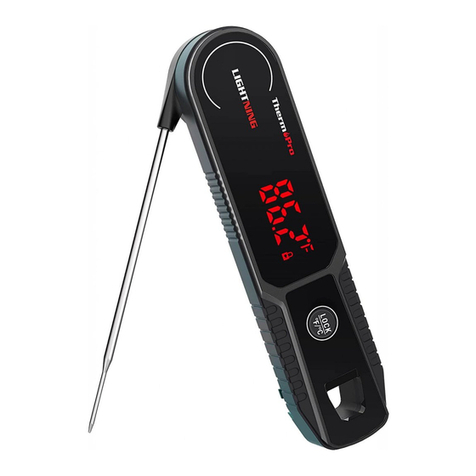
ThermoPro
ThermoPro Lightning TP-622 instruction manual

VOLTCRAFT
VOLTCRAFT UKT-100 operating instructions
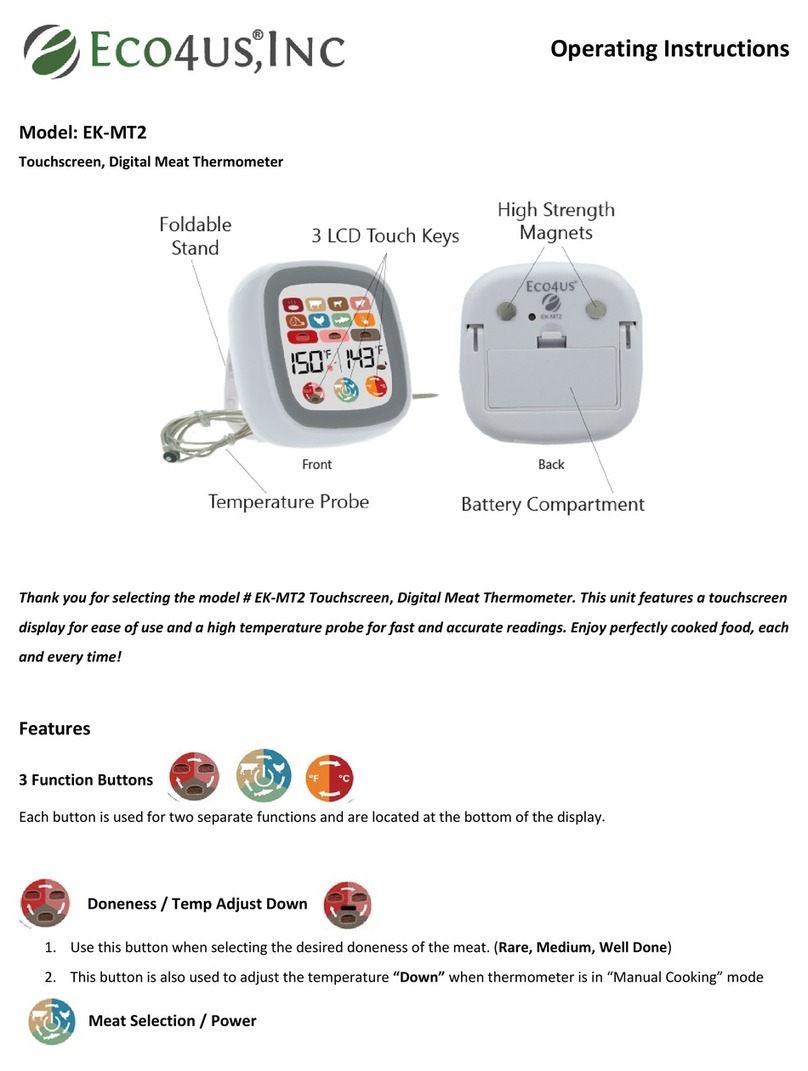
Eco4us
Eco4us EK-MT2 operating instructions
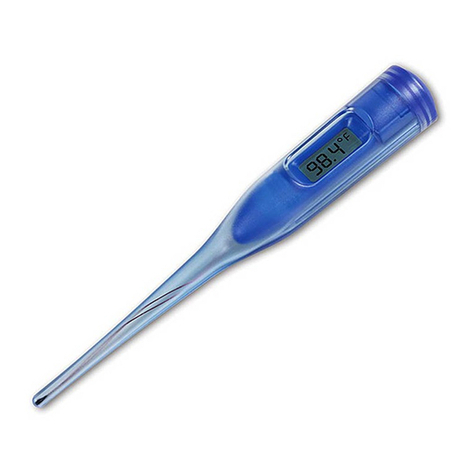
Microlife
Microlife MT16K1-PRO instructions
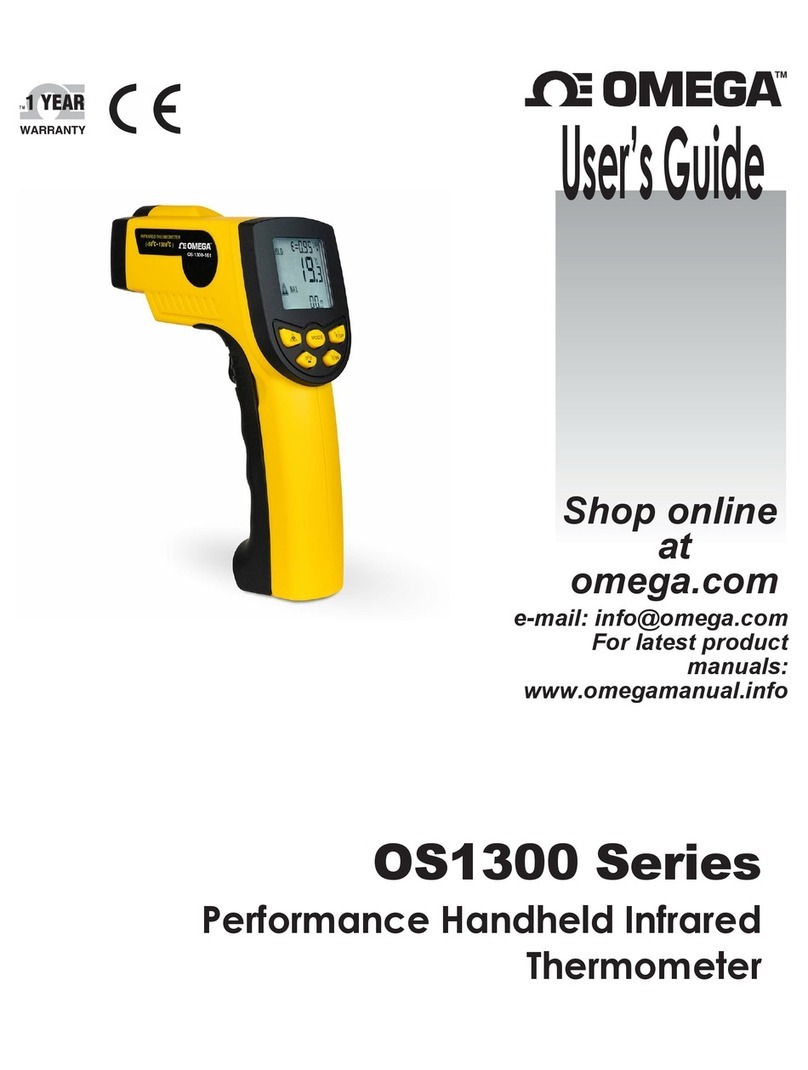
Omega Engineering
Omega Engineering OS1300 Series user guide
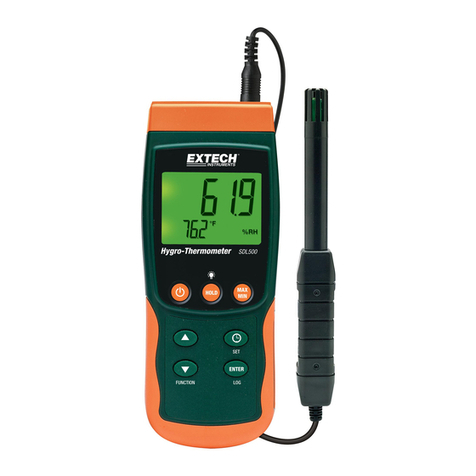
Extech Instruments
Extech Instruments SDL500 user guide

